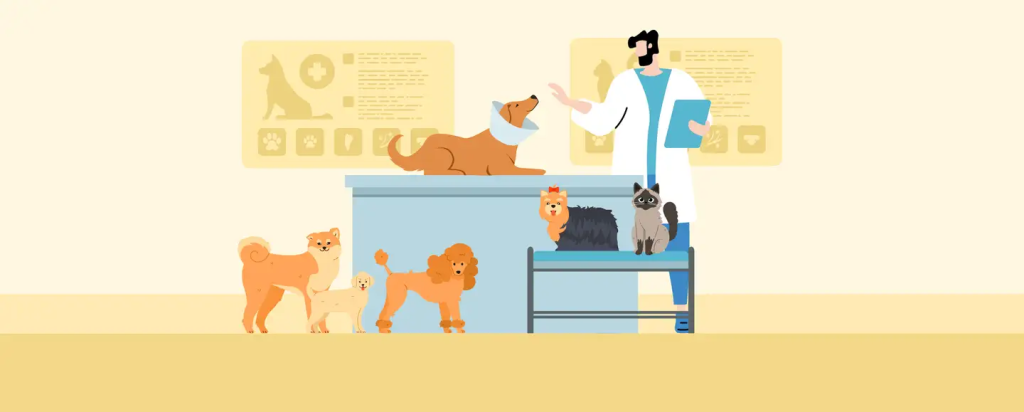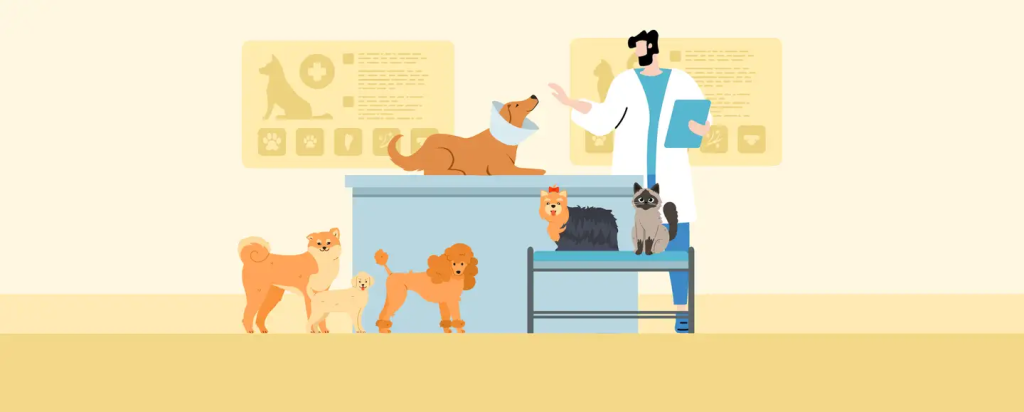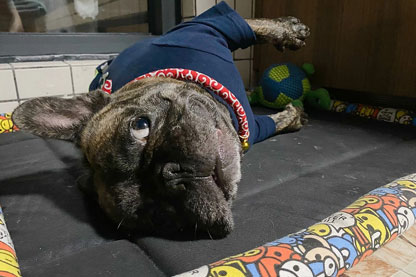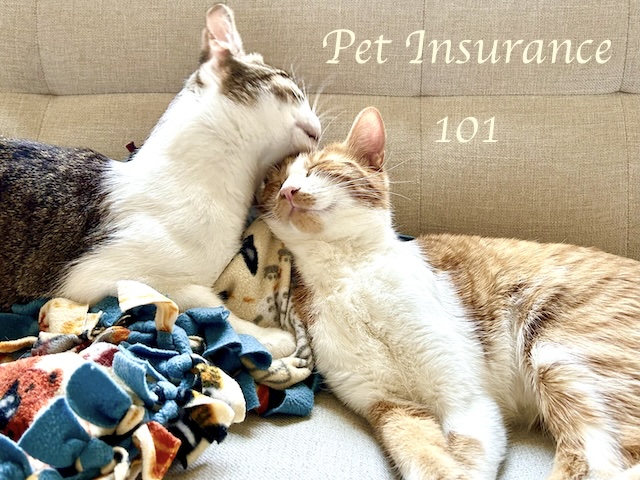

For families with pets, the greatest wish is for their pets to be healthy and happy every day. However, accidents inevitably happen, and if you’re not careful, your furry friends can develop adverse health conditions, which can be very worrying. Today, Huhu will share some practical tips on pet veterinary care in the United States, helping pet families feel less overwhelmed and more prepared when their pets get sick!
1. What symptoms require cats/dogs to see a doctor?
Cats and dogs have their own behavior patterns and personality habits. Every furry friend has his or her own way of life. I believe that owners have a certain understanding of their furry friends. When certain abnormal behaviors or conditions occur, it may be that the furry friends’ bodies are sending out red light warnings. At this time, owners must pay more attention and seek medical attention in time if conditions permit. These conditions usually include:
- Frequent coughing and sneezing. Coughing and sneezing may indicate respiratory discomfort. If accompanied by other symptoms, it is recommended to seek medical attention as soon as possible.
- Loud panting and difficulty breathing. If your pet is breathing abnormally loudly and at an unusually high rate without strenuous exercise, and appears to be struggling to breathe, it could be a heart or lung problem. Seek medical help as soon as possible.
- A sudden decrease or increase in water intake or urine output. If your pet suddenly stops urinating or starts drinking and urinating in large quantities, it could indicate an internal problem. Failure to urinate could indicate a urinary tract problem, while excessive urination could also be a sign of illness. See a doctor for a thorough examination to avoid delaying treatment.
- Vomiting and diarrhea. These two symptoms are relatively common and are generally caused by improper diet or environmental adaptation. However, if vomiting/diarrhea occurs multiple times in a short period of time, or is accompanied by excessive drooling or fever, it is recommended to seek medical attention as soon as possible.
- Significant changes in weight or appetite. Excluding sudden changes in environment or diet, if these occur, you should be aware of them.
- Frequent scratching of the skin, abnormal skin surface, hair loss, etc. If your pet suddenly scratches certain parts frequently, or has hair loss or dry skin in certain parts, then your pet may have skin problems and needs to go to the pet hospital for diagnosis and medication.
- If an adult pet experiences symptoms for a week or more in a young pet, or if a pet experiences symptoms multiple times a day, seek medical attention immediately.
- Abnormalities around the eyes and nose. If your pet’s eyes are red, cloudy, have excessive discharge, or have a dry nose, you should seek medical attention as soon as possible. This could indicate a fever or other issues.
- If your pet suddenly limps or experiences significant pain when a certain part of their body is touched, it could be an external or internal injury and you should take them to a veterinary hospital for an X-ray.
2. How to choose a veterinarian when taking your pet to see a doctor?
If your pet is unwell and needs medical treatment, or if you want to learn more about it just in case, choosing the right veterinarian is the first step in treating your pet. The following factors should be considered when searching for a veterinarian:
- Distance from home. It is difficult to predict when a pet will become ill, and it is difficult for ordinary people to judge the severity of the illness. Therefore, if a veterinarian is closer to your home, it is often more convenient and can better provide timely treatment for your pet.
- Reputation and reviews. You can directly view past customer reviews of the service and professionalism on platforms like Google or Yelp, or search for relevant information online. Choosing a veterinarian with a good reputation and good reviews can reduce the chances of making a bad decision.
- Business hours. It is crucial to keep track of the business hours of nearby veterinarians, preferably one that is open 24 hours a day in case of an emergency.
*It is best to drive your pet to the hospital. If you take a taxi, you need to inform the driver in advance or use a taxi app to request a pet-friendly car.
3. Pet Medical Treatment Process
After deciding which veterinary institution to go to, you need to follow certain procedures when taking your pet to see a doctor. Usually, the process of seeing a pet doctor is as follows:
- Make an appointment by phone or online: After selecting a veterinary hospital or clinic, you can call or check the official website to schedule an appointment to confirm the time, doctor, condition, and other information. Walk-ins are not recommended unless it is an emergency.
- Go to the pet hospital or veterinary clinic: Go to the pet hospital or veterinary clinic to check in 10-15 minutes before the appointment time. Remember to bring your pet’s insurance card, pet’s medical records and relevant examination reports, and wait for the veterinarian to call your number.
- Examination: When entering the clinic, first communicate with the veterinarian about your pet’s condition, diet, living habits, etc. The doctor will conduct a preliminary physical examination to confirm whether further examination is necessary. Further examination may include blood tests, X-rays, etc.
- Communicate with your veterinarian for treatment : Based on the examination and results, as well as the specific circumstances of your pet and family, your veterinarian will provide a treatment plan and prescribe medications, and sometimes perform surgery.
- Collecting medication/postoperative care: The doctor will give you medication prescriptions and postoperative precautions. You need to follow the doctor’s instructions to give your pet medication and provide care.
- Checkout: After treatment, you will need to check out at the front desk. When checking out, you will need to present your pet’s insurance card, medical records, and other information, and pay the treatment fee.
- Organize and submit claim materials: If you have purchased pet insurance, you can organize the required documents and submit them to the insurance company for claim settlement.
4. Urgent Care vs. Emergency Room
Urgent care and emergency rooms are both facilities used to respond to sudden pet emergencies, and both share some common advantages and disadvantages:
Advantages:
- Quick access to professional medical care: Both can provide pets with quick and professional services in emergency situations.
- Access to advanced medical equipment and technology: Urgent care centers and emergency rooms are equipped with high-end medical equipment to save pets in emergencies.
- Provide round-the-clock service: Both are usually open 24 hours a day and can help pets in the most timely manner.
Disadvantages:
- Higher costs: Maintenance, high-end equipment, and 24-hour hours make urgent care centers and emergency rooms more expensive.
- The waiting time is longer during peak periods such as evenings and weekends: the time periods when general veterinary clinics or pet hospitals are not open may become peak periods for both.
- The environment at an emergency medical facility is often tense and busy, and not as comfortable as at regular clinics and hospitals.
The difference between Urgent care and Emergency room is:
- Different service objects: Urgent care mainly provides treatment for some moderate emergency situations for pets, while the emergency room mainly deals with more serious and urgent situations, such as serious trauma, poisoning, etc.
- Different medical equipment and expertise: Emergency rooms are usually equipped with more advanced medical equipment and more professional medical staff, and can perform more complex and high-risk treatments. Urgent care usually has some common medical equipment and professional medical staff, but may not have the same advanced medical equipment and expertise as emergency rooms.
- Different costs and waiting times: Because emergency room services are more urgent and complex, they are usually more expensive and have longer waiting times. Urgent care services are usually cheaper than emergency room services and have shorter waiting times.
- The overall treatment methods are different: Emergency room mainly deals with life-threatening conditions of pets, usually requiring immediate treatment and surgery to save the pet’s life; while urgent care mainly provides treatment for more urgent but non-critical conditions, usually focusing on rehabilitation and prevention to help pets recover as soon as possible.
Generally speaking, urgent care is better suited for pets with milder conditions than emergency rooms, as less serious conditions may require longer wait times and incur higher costs. However, for serious life-threatening situations, it’s crucial to visit an emergency room promptly. Urgent care is recommended for urgent needs like physical exams or prescription medications. However, accidents like car accidents, falls from heights, and ingestion require immediate attention in an emergency room.
5. How to prescribe medication for pets
It often takes time for pets to fully recover from illness and they need to take medication as directed. So how can you obtain necessary prescription medications for pets in the United States? If you’re using a specific medication for the first time, you’ll need a doctor’s prescription and follow the procedures outlined to schedule an appointment at the relevant facility. The doctor’s appointment process is the same as above. If you need a refill of the same medication later , you can call the veterinary clinic that originally prescribed it and request a refill, or you can use online platforms like Chewy . Online platforms will require you to upload and authenticate the doctor’s prescription at checkout before delivery .
6. What does pet insurance cover?
Pet insurance typically involves a prepayment process followed by a claim settlement, with no distinction between in-network and out-of-network providers . Some pet insurance plans offer installment payment options. Generally speaking, standard pet insurance doesn’t cover preventive and routine care, such as regular checkups, so people often purchase a separate Pet Wellness Plan to cover routine services like checkups and vaccinations. However, some insurance companies allow customers to purchase additional plans to cover essential services on top of their existing pet insurance. You can learn more about pet insurance in the United States by following the link below .
Take Pumpkin Pet Insurance as an example:
Pumpkin claims items:
- Accident and illness testing costs
- Dental disease
- Behavior modification
- Covered prescription dog/cat food
- microchip
- Optional daily care plans, such as vaccines, annual checkups, etc., need to be checked and paid extra when purchasing
Items that Pumpkin does not compensate for:
- Illnesses that occur during the waiting period (the waiting period for Pumkpin is 14 days)
- Any prescription pet food for a pre-existing condition, even if prescribed, dispensed, or recommended by a veterinarian
- Pet grooming project
- Pet pregnancy and breastfeeding
A standard pet wellness plan typically covers routine pet care expenses, such as vaccines, deworming, and routine checkups. Reimbursement varies depending on the cost, with basic plans covering only the most basic items, while more advanced plans can cover dental expenses and certain surgeries. Sometimes, plans limit pet expenses, such as limiting annual deworming costs to just a few dozen dollars. Click here to get your pet insurance quote!
7. Things to note when taking your pet to the doctor
In addition to understanding the basic knowledge related to pet medical treatment, Hu Hu also wants to share with you some precautions for pet medical treatment:
- Confirm the veterinarian’s qualifications and evaluation: Choose a veterinarian with professional medical qualifications and high evaluation to avoid being treated by someone without medical qualifications.
- Understand your pet’s physical condition and daily living habits: When you find that your pet has any abnormalities, you need to pay attention to and record the pet’s mental state, diet and excretion in a timely manner. You can also record a video to provide detailed information to the veterinarian.
- Bring all required documents: pet’s medical records, insurance policies, etc.
- Properly house your pet: Some pets are more easily startled, and veterinary clinics often have other animals present. Therefore, if your pet is sensitive to changes in the environment and other animals, it is recommended that you place it in a pet bag or covered pet cage before taking it to the veterinary clinic. If your pet is potentially aggressive, you should also take appropriate measures to control it to avoid accidental injury.
- Consider bringing cushions and toys: Bringing cushions increases your pet’s comfort, and bringing favorite items can reduce tension and provide distraction.
- Prevent cross infection : Before taking your pet to the veterinary hospital, try to avoid contact with other sick pets to reduce the risk of cross infection.
- Cooperate fully with the veterinarian: Cooperate with the veterinarian to complete the examination or surgical procedure, follow the veterinarian’s diagnosis and treatment recommendations, and take medication or treatment on time.
- Disinfection in time: After returning home from the pet hospital, the items you bring with you should be carefully disinfected, and the owner should also keep himself clean to avoid bringing germs home.
- Observe your pet’s reaction: Carefully observe your pet’s reaction during treatment and contact your veterinarian promptly if any abnormal symptoms occur.
- Pay attention to diet and rest: Pay special attention to your pet’s diet and rest during illness. Providing adequate nutrition and rest time will help your pet’s recovery.
- Regular physical examinations and vaccinations: Regular examinations can detect adverse physical conditions early and provide treatment, and vaccinations can prevent the spread and occurrence of certain diseases. Owners who have the conditions must ensure the completion of physical examinations and vaccinations.



